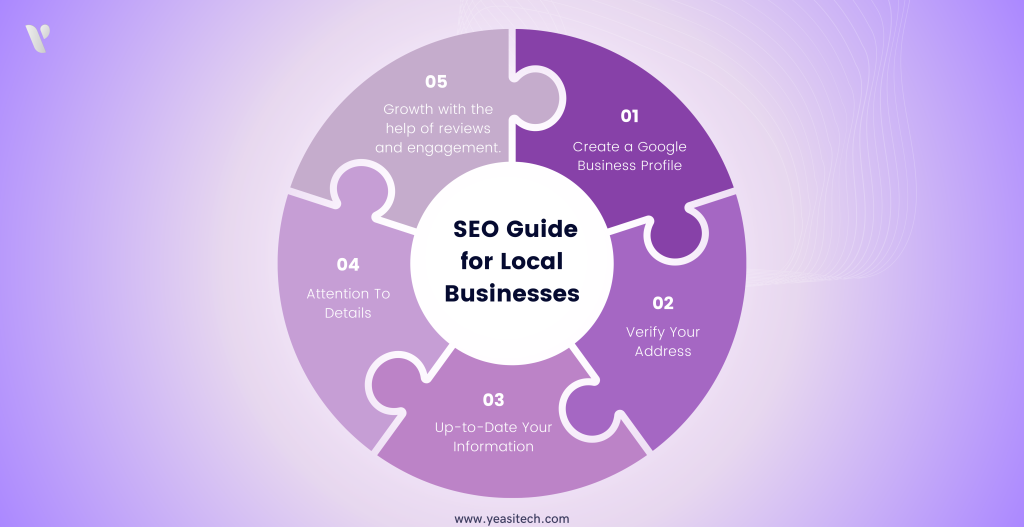SEO for Local Businesses Ready to Dominate 2025

One thing is clear in 2025: As businesses adjust to the rapidly evolving digital environment, SEO for local businesses will be revolutionary. SEO isn’t simply an option for Indian local businesses; it’s essential for expansion and continued competitiveness, particularly in bustling cities like Bangalore, Delhi, and Mumbai. Local SEO may make a big difference in how you stand out from the competition and connect with your target audience, whether you run a café, shop, or provide plumbing services.
As of January 2024, over 40% of Google searches were focused on local information, according to Statista. This emphasizes how important it is for companies to maximize their internet visibility for customers near them. The importance of SEO for local businesses has been emphasized by recent changes to the Google algorithm, such as the “Google Maps Update” of 2023, particularly for companies that rely on local customers. We’ll cover useful SEO strategies in this article to help your company stand out in the local market.
SEO for local businesses is about improving a company’s online visibility to attract customers from specific local areas. This includes using location-based keywords, setting up Google My Business profiles, and getting local backlinks to show up better in local search results, which helps bring in more nearby customers and leads.
Here’s a table comparing SEO and Local SEO, highlighting their key differences :
| Aspect | SEO | Local SEO |
| 1. Definition | Optimizing a website for broader search visibility. | Targeting local searches to attract nearby customers. |
| 2. Target Audience | Global or national audience. | Local customers in specific geographic areas. |
| 3. Keywords | General keywords (e.g., “best pizza restaurant”). | Localized keywords (e.g., “best pizza in Kolkata”). |
| 4. Examples | Amazon, eBay – compete on a national scale. | Joe’s Pizza – relies on local customers and foot traffic. |
| 5. Search Results | Ranks on global search engines (e.g., Google). | Ranks in local search results, maps, and directories. |
| 6. Backlinks | Focus on acquiring high-quality, authoritative links. | Local backlinks from local newspapers, blogs, or events. |
| 7. Content | Broad content strategy targeting various topics. | Location-specific content, like community events or local guides. |
| 8. Success Measurement | Traffic, conversion rates, and keyword rankings. | Local foot traffic, calls, and Google Maps visibility. |
Of course! Since more customers are looking for local businesses online, business owners must adapt their tactics. Whether you use a local SEO strategy or not, your competitors will. They will be well ahead of you and profitable before you realize it.
There’s a good reason for this: e-commerce websites are leading the way. Online stores are worth trillions of dollars, and physical stores can gain from their strategies.

Create a Google account for your company and first set up a Google Business Profile. Don’t bother about keywords or SEO at this moment. All that has to be done is create the profile and fill it up as much as possible. You don’t have to go into too much detail right now if time is of the importance. It’s important to get the process going since, in the absence of a company profile, you can be losing out on possible revenue.
Businesses and brands nowadays must obtain social media verification. Although it may appear like an extra inconvenience, this procedure guards against fraudsters and makes it more difficult for others to pose as you. The verification process has five steps that you can complete on your computer or smartphone through Google’s website.
You must include complete data on your internet company profile. Add your business’s name, address, and operating hours; don’t forget to include holiday operating hours, descriptions, and images. Being thorough is essential to a successful local SEO strategy. Your search engine rating will improve the more accurate the information you supply. Google may penalize you for mistakes!
When listing your business’s details, accuracy is essential. Even little errors, such as the wrong working hours, can hurt earnings and ranking. When users see faults, they may decide not to purchase anymore. Please update your information often, including holiday hours, to make sure there are no common errors.
It takes time to set up a Google Business Profile. Reviews will be left for you (ideally with five stars!), therefore, you must read and reply to them. It’s also a good idea to sometimes post fresh pictures. A higher rating comes from being active, which increases the number of individuals who notice your company listing.

Below are the most impactful SEO strategies for Local Businesses to increase traffic and sales from organic search.
The creation and maintenance of your Google My Business (GMB) page is an important component of local SEO. GMB links your company with customers nearby who are looking for your goods or services.
Reasons for Its Importance:
According to a BrightLocal poll, 64% of customers have looked up local businesses using Google My Business, highlighting the platform’s importance for attracting new clients.
How to Implement It:
Real Life Example:

A significant increase in local visitors was observed by Dr. Batra’s, one of the largest chains of homeopathic clinics in India, following an upgrade to their Google My Business (GMB) page. Within six months, they increased foot traffic by thirty percent by adding service-related keywords and often updated their GMB listing with new photos and updates.
A SEO strategy’s most important aspect is keyword selection. It’s important to concentrate on keywords for local SEO that demonstrate local search intent. Your business may show up in local search results if you use long-tail keywords with precise locations (such as “best bakery in Kolkata”).
How to Implement It:
Real Life Example:

The luxury villa rental business SaffronStays in Mumbai concentrated on regional keywords such as “weekend getaways near Mumbai.” They increased their organic search traffic by 45% in just a single year by focusing on these highly-intent local queries, which resulted in an increase in bookings.
With 82% of smartphone users conducting “near me” searches, mobile searches have now overtaken desktop searches. To increase local SEO, you must optimize your website for mobile devices because Google favors mobile-friendly websites.
How to Implement It:
Real Life Example:

India’s leading food delivery service, Zomato, has improved the usability and speed of both its website and app. This increased the number of people making orders while looking for nearby restaurants on their phones and resulted in a 25% increase in mobile traffic.
Your SEO rankings may be significantly raised by producing content that highlights regional events, cultures, and communities. It improves the credibility and confidence that your audience has in your website while also improving its search engine ranking.
How to Implement It:
Real Life Example:

One of the biggest chains of coffee shops in India, Cafe Coffee Day (CCD) introduced a hyper-local blog approach in many Indian towns. They published content relevant to local audiences, including café reviews, local events, and interviews with regular customers. This strategy resulted in a 20% increase in website traffic and improved their local SEO performance, especially in smaller cities.
Online reviews have a significant impact on a business’s trustworthiness and are important for local search results. According to BrightLocal research, 12% of customers regularly look for local companies online, while 87% of consumers read online reviews for local businesses.
How to Get More Reviews:
Real Life Example:

Pepperfry, the top marketplace for furniture and home items in India, improved its local SEO by emphasizing user feedback. They incentivized reviews and ensured quick responses to feedback. They received over 1,000 fresh reviews in only six months because of this campaign, which also improved consumer engagement and local rankings by 15%.
Backlinks from reputable local businesses or organizations can help improve your local SEO. Google considers these links as votes of confidence, and acquiring backlinks from local sites can boost your business’s visibility in your community.
How to Implement It:
Real Life Example:

FabIndia, a retail giant, built a local SEO strategy focused on community partnerships and local backlinks. They partnered with small businesses and local NGOs, earning valuable backlinks to their site. As a result, their online visibility in India’s tier-2 and tier-3 cities increased by 40%, and local store visits grew significantly.
People are starting to use voice search more frequently to find local businesses. Voice searches account for 20% of all smartphone searches, according to Google. It’s important to concentrate on voice search optimization in light of the rise in smart assistants like Siri, Alexa, and Google Assistant.
How to Implement It:
Real Life Example:

UrbanClap, one of India’s leading platforms for home services, improved voice search on its website. They become more visible in voice searches for terms like “electrician open now” and “home cleaning near me” because to this modification. They thus saw a 10% rise in service reservations made via mobile devices.
You may add a sort of coding called schema markup to your website to assist search engines in displaying more relevant content. Local companies may use local schema markup to show information like as business hours, reviews, and contact data on their website, increasing their visibility in search results.
How to Implement It:
Real Life Example:

BigBasket, the top online grocery store in India, has used local schema markup to provide crucial company details like delivery zones and business hours. Their organic click-through rate (CTR) increased by 12% as a consequence of this modification, as visitors found the search results to be more pertinent and helpful.
In an era where digital-first customers expect to find everything online, investing in local SEO isn’t just a smart choice—it’s a necessity. Follow these tips, keep adapting to changes in search algorithms, and watch your local business grow exponentially.
Staying updated with the latest trends in SEO is vital for long-term success. For further insights and tips on digital marketing and SEO strategies customized for local businesses, visit YeasiTech and explore our blog page.
We provide valuable resources that can help you navigate the constantly changing field of Internet marketing. Adopt these tactics, and observe how your local business prospers in the internet era!
Local SEO refers to the process of optimizing a business’s online presence to attract more customers from relevant local searches. It involves strategies that help businesses rank higher in search results for location-based queries.
A Google Business Profile is crucial because it enhances visibility on Google Search and Maps. A well-optimized profile can lead to more clicks, phone calls, and foot traffic to your business.
You can find local keywords using tools like Google Keyword Planner, SEMrush, or Ubersuggest. Focus on terms that include your location and specific services you offer.
Online reviews are critical for local SEO as they influence rankings and consumer trust. Businesses with positive reviews are more likely to appear higher in local search results and attract new customers.
YeasiTech is a trusted IT service partner with 8+ years of experience, empowering 250+ businesses with scalable web, mobile and AI solutions.
Explore related topics to broaden your understanding and gain actionable insights that can transform your strategies.